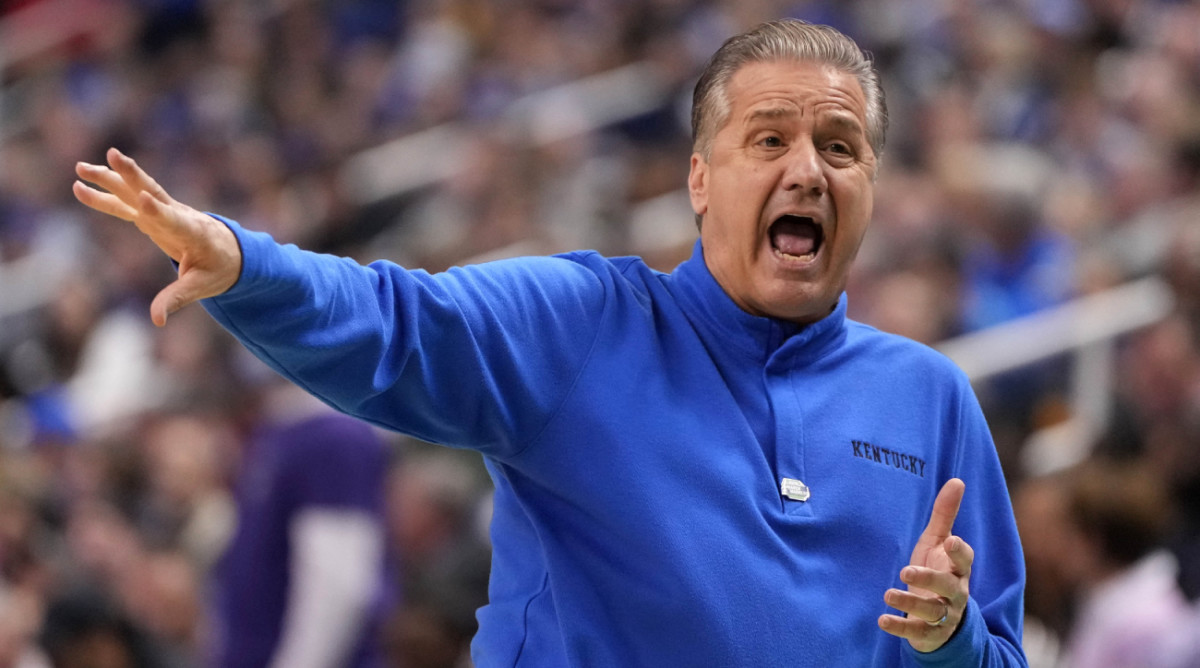College Hoops Is Following the NBA’s Path Toward a More Global Game

NBA trends tend to take their time trickling down to the college game. Several modern concepts—how to use pace and space offensively, a ball-screen-centric style of play—are just now beginning to influence college basketball. And as high-profile moves at some of the nation’s biggest programs over the past week have shown, the NBA and basketball’s global tilt has officially reached college hoops.
In the first 50 years of the Naismith College Player of the Year award, only five players from outside the United States earned the honor, and two (Butch Lee in Puerto Rico, Tim Duncan in the U.S. Virgin Islands) of those were born on American soil. But the last two winners (Oscar Tshiebwe from Congo and Zach Edey from Canada) were born abroad. Although both played prep basketball in the U.S., there has been a major shift lately in the impact of global recruiting.
Overseas recruiting used to be a niche taken advantage of by only a few of the top programs. Gonzaga’s rise can be credited in large part to Mark Few and longtime top assistant Tommy Lloyd’s willingness to go abroad for talent: think Domantas Sabonis, Przemek Karnowski, Rui Hachimura and Ronny Turiaf. Even Canadians like Kevin Pangos and Kelly Olynyk fit the mold.

It’s different now, and moves in the past week illustrate that as much as anything. Kentucky has recruited plenty in Canada over the years, but John Calipari turning to a European prospect with no stateside experience in 7’2” Zvonimir Ivisic of Croatia felt like a notable shift in the importance of global recruiting. Ivisic, a skilled big man who has drawn comparisons to Kristaps Porziņģis and tested the NBA draft waters this past summer, is about as highly touted a European prospect as there has been in a long time. Ivisic also joins a program that doesn’t have the same track record with international players as some others do.
A fellow blueblood, Kansas, went to Australia for a commitment this week, landing stock-rising Johnny Furphy after a strong summer with a U.S.-based NBA Academy team. He received late interest from North Carolina and Duke and caught the eye of some NBA scouts at recruiting events in July.
Meanwhile, UCLA is poised to announce the additions of two more potential NBA prospects from Europe in the coming days: 7’3” Spanish big Aday Mara and skilled 6’9” Turkish forward Berke Buyuktuncel, both of whom are fresh off big performances for their respective national teams. Mara, by some prognosticators, is a potential top-10 pick in next year’s NBA draft. In all, the Bruins are set to add five European prospects to their roster this spring.
The list goes on. Arizona (now coached by Lloyd) has a roster built with more than half of its players from outside the U.S. West Virginia just went to Israel to find its latest commit, while Xavier recently raided a Lithuanian college to round out its roster. Utah, Minnesota, Florida and Penn State are among other high-majors that have turned globally for a commit this spring. Why?
The talent gap between the U.S. and the rest of the basketball-playing world has shrunk, as evidenced by the global nature of the NBA’s superstar class. (The league hasn’t had a U.S.-born MVP since 2018.) Team USA came in fourth place behind Spain, France and Turkey at the FIBA U19 World Cup in July. There’s also an increasing narrative from voices throughout the basketball world that development structures in place overseas are better for young players than the ones in the U.S.
“Here’s the difference: Everywhere but America, sports are not related to school,” UCLA coach Mick Cronin said in a recent appearance on the Petros and Money radio show. “Everything is club, and there are junior teams that are tied underneath professional teams. They don’t have the confines of the academics that limits high school coaches in every state. … Any time a European kid has played basketball, [he] has been coached. There’s no pickup basketball. … They’re more mature in their understanding of moving without the ball, passing the ball, concepts.”
Cronin also believes he can coach international players harder because of their experiences in the youth system.
“Their coaches get fired quickly over there, so it’s high intensity,” Cronin said. “Part of that I love, because they think I’m a nice guy compared to their European coaches.”
Plus, the ability for players to earn money through name, image and likeness—even if it requires creativity surrounding where the work is done to comply with U.S. immigration law—has opened the door to more top international prospects considering the college route. ESPN NBA draft analyst Jonathan Givony, an expert on the international game, described an ongoing “sea change,” with college basketball now “significantly more attractive” than it had been for elite international players. That has made events like FIBA’s U18 European Championship an increasingly popular stop for high-level coaches during the packed summer recruiting calendar. Even staffs that didn’t send a coach to Serbia for the event in many cases watched it from home on livestreams.
College basketball rosters will likely never quite reach the NBA’s level of global diversity, where five of 10 All-Star starters this year were born outside the U.S. Strong development structures are in place overseas for international players to turn into pros, and the cache of playing in the NCAA tournament and for historic brands that keep American players coming to college doesn’t resonate as much with players not born Stateside. But the recent influx of international talent to the college game is the clear sign of a shifting landscape and a trend that doesn’t seem likely to slow down anytime soon.
